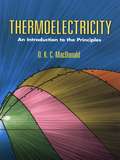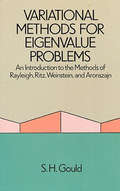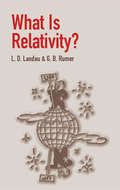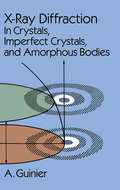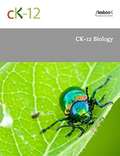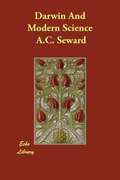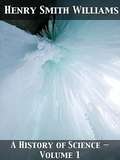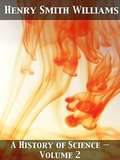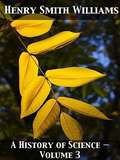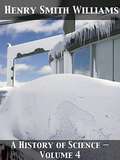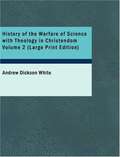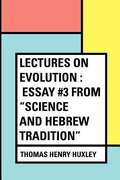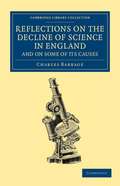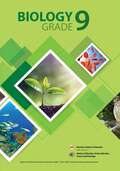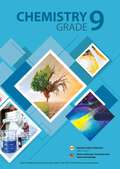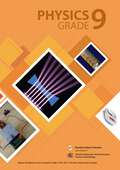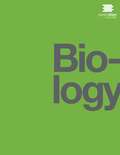- Table View
- List View
Thermoelectricity: An Introduction to the Principles
by D. K. MacDonaldThis introductory treatment provides an understanding of the fundamental concepts and principles involved in the study of thermoelectricity in solids and of conduction in general. Aimed at graduate-level students and those interested in basic theory, it will be especially valuable to experimental physicists working in fields connected with electron transport and to theoreticians seeking a survey of thermoelectricity and related questions.Chronicling the early history of thermoelectricity from its discovery to modern times, this text features a considerable amount of experimental data and discusses these findings at length wherever they bear a particular relevance to theory. The author, a well-known authority in this field, draws heavily from his own work on thermoelectrical phenomena as they are observed in the study of metals. Numerous illustrative figures appear throughout the text.
Variational Methods for Eigenvalue Problems: An Introduction to the Methods of Rayleigh, Ritz, Weinstein, and Aronszajn
by S. H. GouldThe importance of eigenvalue theory in pure and applied mathematics, and in physics and chemistry, makes it incumbent on students to understand the various methods of approximate calculation of eigenvalues. It is especially important to develop such methods in a general and theoretical manner, if only to avoid missing opportunities for particular applications. This book does just that, approaching the topic from a purely mathematical standpoint.Because variational methods are particularly well adapted to successive approximation, this book gives a simple exposition of such methods, not only of the familiar Rayleigh-Ritz method, but especially of the related methods — the Weinstein method, Weinstein-Aronszajn method, and others. To make the book accessible to a broad range of students, little mathematical knowledge is presupposed beyond the elements of calculus. Where specialized knowledge is required — as it is in the discussion of direct methods in the calculus of variations and the theory of completely continuous operators in Hilbert space — the requisite material is developed in full.The first nine chapters, written in elementary style, discuss the general theory of variational methods with special reference to the vibrating plate. In the last chapter, the information gained thereby is extended, in a less elementary way, to more general cases. Exercises are provided throughout to illuminate the ideas and methods developed in the text.
What Is Relativity? (General Science)
by G. B. Rumer L. D. LandauThis compelling book offers readers with no technical expertise beyond arithmetic an enlightening tour of the paradoxes inherent in the special theory of relativity, guided by a pair of eminent theoretical physicists.Novel Prize physicist L. D. Landau and his distinguished colleague G. B. Rumer, employ a simple and straightforward manner to illuminate relativity theory's more subtle and elusive aspects. Using such familiar objects as trains, rulers, and clocks, the authors explain the reasoning behind seemingly self-contradictory ideas in which the relative seems absolute, but the absolute proves to be relative. A series of playful cartoons highlights the authors' witty observations on the laws governing inertia, the speed of light, the relationship of work and mass, and other relativistic concepts.
X-Ray Diffraction: In Crystals, Imperfect Crystals, and Amorphous Bodies (Dover Books On Physics Series)
by A. GuinierThis valuable text begins with the general theory of diffraction through the use of Fourier transforms. The author then applies the general results to various atomic structures including amorphous bodies, crystals, and imperfect crystals, whereby the elementary laws of x-ray diffraction from ideal structures follow as a special case. The presentation has been carefully developed to illustrate clearly the meaning of the general equations essential for the study of more complex cases.Readers are assumed to be familiar with the elements of crystallography and x-ray diffraction, and the author has not discussed the problem of determining crystal structures. Rather the focus is on the great variety of imperfect crystals as well as amorphous bodies and liquids. The book should thus be especially useful solid-state physicists, materials scientists, chemists, and biologists with an interest in the scattering from defective structures. More generally, it will benefit all who require a thorough understanding of diffraction theory in order to interpret properly the information provided by modern x-ray diffraction instruments on line profiles, line intensities, diffuse scattering and other phenomena associated with disorder.
CK-12 Biology I (with image descriptions)
by Ck-12 FoundationOpen source biology textbook from CK-12.
A Critical Examination of the Position of Mr. Darwin's Work, "On the Origin of Species"
by Thomas Henry HuxleyN/A
A CRITICAL EXAMINATION OF THE POSITION OF MR. DARWIN'S WORK, "ON THE ORIGIN OF SPECIES,"
by Thomas Henry HuxleyA Critical Examination of the Position of Mr. Darwin's Work, "On the Origin of Species," in Relation to the Complete Theory of the Causes of the Phenomena of Organic Nature Lecture VI. (of VI.), "Lectures to Working Men", at the Museum of Practical Geology, 1863, on Darwin's Work: "Origin of Species"
Darwin and Modern Science
by A. C. SewardThe Cambridge Philosophical Society collected this series of essays in commemoration of the centenary of the birth of Charles Darwin and the 50th anniversary of the publication of The Origin of Species. Aiming to be accessible to the 'educated layman', the eminent contributors reviewed the impact of Darwin's ideas in many spheres. They addressed contemporary (1909) attitudes, Darwin's theories and their far-reaching implications, and the progress of new lines of research that had emerged from them. The diversity of views among biologists regarding both the origin of species and the best directions for further research is clearly evident. In his work, Darwin had sought only the truth, writing 'Absolute accuracy is the hardest merit to attain, and the highest merit. Any deviation is ruin.' However dramatic the controversies he stirred, what shines from these essays is profound admiration for both Darwin's intellect and the quality of his character.
A History of Science -- Volume 1
by Edward Huntington Williams Henry Smith WilliamsShould the story that is about to be unfolded be found to lack interest, the writers must stand convicted of unpardonable lack of art. <P> <P> Nothing but dulness in the telling could mar the story, for in itself it is the record of the growth of those ideas that have made our race and its civilization what they are; of ideas instinct with human interest, vital with meaning for our race; fundamental in their influence on human development; part and parcel of the mechanism of human thought on the one hand, and of practical civilization on the other. Such a phrase as “fundamental principles” may seem at first thought a hard saying, but the idea it implies is less repellent than the phrase itself, for the fundamental principles in question are so closely linked with the present interests of every one of us that they lie within the grasp of every average man and woman— nay, of every well-developed boy and girl. These principles are not merely the stepping-stones to culture, the prerequisites of knowledge— they are, in themselves, an essential part of the knowledge of every cultivated person
A History of Science -- Volume 2
by Edward Huntington Williams Henry Smith WilliamsThe studies of the present book cover the progress of science from the close of the Roman period in the fifth century A. D. to about the middle of the eighteenth century. In tracing the course of events through so long a period, a difficulty becomes prominent which everywhere besets the historian in less degree— a difficulty due to the conflict between the strictly chronological and the topical method of treatment. <P> <P> We must hold as closely as possible to the actual sequence of events, since, as already pointed out, one discovery leads on to another. But, on the other hand, progressive steps are taken contemporaneously in the various fields of science, and if we were to attempt to introduce these in strict chronological order we should lose all sense of topical continuity.
A History of Science -- Volume 3
by Edward Huntington Williams Henry Smith WilliamsWith the present book we enter the field of the distinctively modern. There is no precise date at which we take up each of the successive stories, but the main sweep of development has to do in each case with the nineteenth century. <P> <P> We shall see at once that this is a time both of rapid progress and of great differentiation. We have heard almost nothing hitherto of such sciences as paleontology, geology, and meteorology, each of which now demands full attention. Meantime, astronomy and what the workers of the elder day called natural philosophy become wonderfully diversified and present numerous phases that would have been startling enough to the star-gazers and philosophers of the earlier epoch.
A History of Science -- Volume 4
by Edward Huntington Williams Henry Smith WilliamsAS regards chronology, the epoch covered in the present volume is identical with that viewed in the preceding one. But now as regards subject matter we pass on to those diverse phases of the physical world which are the field of the chemist, and to those yet more intricate processes which have to do with living organisms. <P> <P> So radical are the changes here that we seem to be entering new worlds; and yet, here as before, there are intimations of the new discoveries away back in the Greek days. The solution of the problem of respiration will remind us that Anaxagoras half guessed the secret; and in those diversified studies which tell us of the Daltonian atom in its wonderful transmutations, we shall be reminded again of the Clazomenian philosopher and his successor Democritus.
History of the Warfare of Science with Theology in Christendom
by Andrew Dickson WhiteWallpaper* City Guidesnot only suggest where to stay, what to eat, and what to drink, but what the tourist passionate about design might want to see, whether he or she has a week or just 24 hours in the city. <P> <P> Some of the highlights include up-and-coming neighborhoods, an `Architour? of landmark buildings, design centers, and the best shops to buy unique items. Wallpaper* City Guidespresent travelers with a fast-track ticket to the chosen location. The tightly-edited guides offer the best, most exciting, and the most beautiful of the featured city. The guides are expertly designed with function as a priority, and they have tabbed sections so that readers can find information easily. The guides include currency rate information, maps, and a color-coding system to help the reader navigate through different parts of the city. They are the ultimate combination of form and function. The guides are compiled byWallpaper*magazine experts and their extraordinary network of international correspondents. The writers have put their heads together to come up with fascinating, efficient guides for the hip, urban traveler with his or her finger on the pulse. They are truly the insider's guide to each featured city. The firstWallpaper* City Guideswere published in Fall 2006 on the occasion ofWallpaper*?sfirst anniversary. For more than a decade,Wallpaper*has been the first to uncover and enticingly present the best urban travel spots from across the globe. The City Guides are the perfect way to present a decade of experience in one precisely edited guide. As of early 2010, there are 80 city guides available, with seven more on the way by the end of the year.
Lectures on Evolution
by Thomas Henry HuxleyThomas Henry Huxley was popularly known as "Darwin's Bulldog," and that's because the 19th century scientist was a forceful advocate for Darwin's theory of evolution. Huxley himself also wrote at length on the topic.
Records of a Family of Engineers
by Robert Louis StevensonTrajectory presents classics of world literature with 21st century features! Our original-text editions include the following visual enhancements to foster a deeper understanding of the work: Word Clouds at the start of each chapter highlight important words. Word, sentence, paragraph counts, and reading time help readers and teachers determine chapter complexity. Co-occurrence graphs depict character-to-character interactions as well character to place interactions. Sentiment indexes identify positive and negative trends in mood within each chapter. Frequency graphs help display the impact this book has had on popular culture since its original date of publication. Use Trajectory analytics to deepen comprehension, to provide a focus for discussions and writing assignments, and to engage new readers with some of the greatest stories ever told. "Records of a Family of Engineers" by Robert Louis Stevenson recounts the history of the Stevenson family and lighthouse engineering.
Reflections on the Decline of Science in England, and on Some of Its Causes
by Charles BabbageThe mathematician Charles Babbage (1791-1871) was one of the most original thinkers of the nineteenth century. In this influential 1830 publication, he criticises the continued failure of government to support science and scientists. In addition, he identifies the weaknesses of the then existing scientific societies, saving his most caustic remarks for the Royal Society. Asserting that the societies were operated largely by small groups of amateurs possessing only superficial interest and knowledge of science, Babbage explores the importance of the relationships between science, technology and society. Exposing the absence of a true scientific culture, he states, 'The pursuit of science does not, in England, constitute a distinct profession, as it does in other countries. ' These concerns found favour with many, influencing reforms of the Royal Society and leading to the founding of the British Association.
Biology class 9 - MIE
by Mauritius Institute of EducationThe Grade 9 Biology textbook from the Mauritius Institute of Education covers four comprehensive units. The first unit delves into the intricacies of the human Blood Circulatory System, exploring the structure and functions of blood, the heart, and blood vessels. It addresses topics like blood cell types, pulse, and cardiovascular diseases. The Reproduction unit explores both asexual and sexual reproduction in living organisms, detailing the structures and functions of human male and female reproductive systems, fertilization, embryo development, and the significance of reproductive health. The Biodiversity unit introduces the concept's importance for survival, explaining how to estimate species using quadrats and addressing factors affecting biodiversity. The final unit, Nutrition in Plants, delves into photosynthesis, emphasizing factors like light, carbon dioxide, water, and chlorophyll, and includes practical demonstrations on starch presence in leaves.
Chemistry class 9 - MIE
by Mauritius Institute of EducationThe Grade 9 Chemistry textbook published by the Mauritius Institute of Education in 2023 covers five comprehensive units designed to provide students with a foundational understanding of key chemical concepts. Unit C1 delves into the composition of air, exploring topics like the greenhouse effect, global warming, and pollution, while also suggesting measures for environmental protection. Unit C2 focuses on mixtures and separation techniques, introducing methods like sublimation and crystallization. Unit C3 teaches the language of chemistry, encompassing symbols, valencies, and chemical equations. Unit C4 explores the properties and reactions of metals, introducing the reactivity series and displacement reactions. Finally, Unit C5 delves into the formation, classification, and properties of salts, including common examples. Each unit is rich with activities, diagrams, tables, and exercises to engage students and foster their understanding of these fundamental chemistry concepts.
Physics class 9 - MIE
by Mauritius Institute of EducationThe textbook offers a comprehensive overview of Grade 9 Physics from the Mauritius Institute of Education, specifically focusing on the Measurement in Science unit. It includes information on contributors involved in the textbook's creation and review, curriculum alignment with national standards, and an emphasis on incremental content development and scientific skills from previous grades. Learning tools provided encompass inquiry-based activities, summaries, "Find out" features, "Did you know?" sections, project work suggestions, unit summaries, and concept maps for effective learning and assessment. The unit itself covers the measurement of physical quantities such as length, volume, mass, time, and temperature, offering detailed explanations, error avoidance techniques, and practical activities to aid comprehension.
Anatomy & Physiology
by OpenStaxHuman Anatomy and Physiology is designed for the two-semester anatomy and physiology course taken by life science and allied health students. The textbook follows the scope and sequence of most Human Anatomy and Physiology courses, and its coverage and organization were informed by hundreds of instructors who teach the course. Instructors can customize the book, adapting it to the approach that works best in their classroom. The artwork for this textbook is aimed focusing student learning through a powerful blend of traditional depictions and instructional innovations. Color is used sparingly, to emphasize the most important aspects of any given illustration. Significant use of micrographs from the University of Michigan complement the illustrations, and provide the students with a meaningful alternate depiction of each concept. Finally, enrichment elements provide relevance and deeper context for students, particularly in the areas of health, disease, and information relevant to their intended careers.
Biology
by OpenStaxBiology is designed for multi-semester biology courses for science majors. It is grounded on an evolutionary basis and includes exciting features that highlight careers in the biological sciences and everyday applications of the concepts at hand. To meet the needs of today's instructors and students, some content has been strategically condensed while maintaining the overall scope and coverage of traditional texts for this course. Instructors can customize the book, adapting it to the approach that works best in their classroom. Biology also includes an innovative art program that incorporates critical thinking and clicker questions to help students understand--and apply--key concepts.
